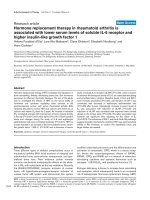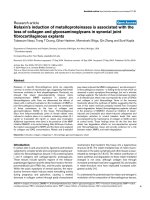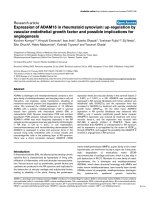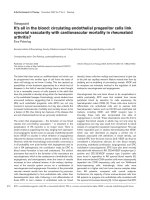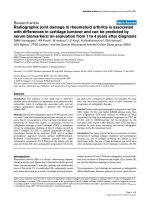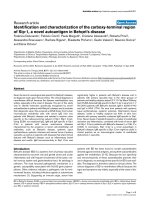Báo cáo y học: "It’s all in the blood: circulating endothelial progenitor cells link synovial vascularity with cardiovascular mortality in rheumatoid arthritis" docx
Bạn đang xem bản rút gọn của tài liệu. Xem và tải ngay bản đầy đủ của tài liệu tại đây (473.41 KB, 3 trang )
270
EPC = endothelial progenitor cells; RA = rheumatoid arthritis; TNF-α = tumour necrosis factor alpha; VEGF = vascular endothelial growth factor.
Arthritis Research & Therapy December 2005 Vol 7 No 6 Paleolog
The belief that there exists an undifferentiated cell which can
be programmed into another type of cell forms the basis of
stem cell biology as we know it today. This has opened up
possibilities of new treatment approaches for a whole host of
diseases. In the field of vascular biology there is also thought
to be a renewable source of cells present in the adult that
have the potential to develop along either the haematopoietic
or the endothelial lineages. Fascinatingly, recent studies have
uncovered evidence suggesting that in rheumatoid arthritis
(RA) such endothelial progenitor cells (EPC) are not only
involved in synovial vascularisation, but may also underlie the
increased cardiovascular morbidity and mortality known to be
a feature of RA, thus linking two features of the disease that
are well characterised but are as yet poorly understood.
The notion that angiogenesis — the formation of new blood
vessels from pre-existing vasculature — is important in the
perpetuation of RA synovitis is no longer novel. There is
ample evidence supporting this idea, ranging from expression
of proangiogenic factors such as vascular endothelial growth
factor (VEGF) to studies in which inhibition of angiogenesis
reduced the disease severity in animal models of arthritis [1].
However, while the rheumatologic and scientific community is
in all probability now quite familiar with angiogenesis and its
role in RA pathogenesis, the contribution made by EPC to
blood vessel formation is less well understood. The distinct
processes that result in the formation of the vasculature are
vasculogenesis, which is the coalescence of endothelial cells,
angiogenesis, and arteriogenesis, when the lumen of vessels
increases to form collateral arteries. In the embryo, develop-
ment of the vascular system occurs via a combination of
vasculogenesis and angiogenesis. Formation of the primordial
vascular network results from the commitment by precursor
cells (haemangioblasts) to form endothelial cells, rather than
haematopoietic stem cells. Following in situ differentiation of
these EPC to form clusters of endothelial cells (or blood
islands), these cells then multiply and interconnect to give rise
to the yolk sac capillary network. Mature vessels then form by
budding and re-modelling of pre-existing vessels. VEGF and
its receptors are intimately involved in the regulation of both
embryonic vasculogenesis and angiogenesis.
Vasculogenesis has now been shown to be recapitulated in
adults postnatally. EPC were first isolated from human
peripheral blood by selection for cells expressing the
haematopoietic maker CD34 [2]. These cells were found to
differentiate into endothelial cells and to express both
haematopoietic markers such as CD133 and endothelial cell
markers, including CD31 and VEGF receptor type 2.
Crucially, these cells also incorporated into sites of
angiogenesis in vivo [2]. These observations were the first to
suggest that blood vessels in adults may not only arise by
angiogenesis, but may also result from recruitment to blood
vessels of a progenitor population (vasculogenesis). This was
further expanded upon in studies demonstrating that VEGF,
which was well described as playing a central role in
diseases associated with alterations in vessel density, can
mobilise EPC from the bone marrow [3,4]. VEGF can thus be
considered a bifunctional stimulus for new blood vessels,
promoting endothelial proliferation (angiogenesis) and EPC
mobilisation (vasculogenesis). EPC have also been recently
described with reference to RA. CD34/VEGF receptor type 2-
positive and CD133/VEGF receptor type 2-positive cells
were found in apposition to RA synovial blood vessels [5].
Bone marrow-derived CD34-positive cells were subsequently
expanded into CD31-expressing cells and von Willebrand
factor-expressing cells. Interestingly, these cells were
generated at a higher rate from bone marrow samples taken
from RA patients, compared with normal subjects.
Furthermore, the capacity of bone marrow-derived cells from
RA patients to progress into endothelial cells correlated with
the synovial microvessel density [6]. It thus appears that EPC
Viewpoint
It’s all in the blood: circulating endothelial progenitor cells link
synovial vascularity with cardiovascular mortality in rheumatoid
arthritis?
Ewa Paleolog
Kennedy Institute of Rheumatology, Faculty of Medicine, Imperial College, Arthritis Research Campaign Building, London, UK
Corresponding author: Ewa Paleolog,
Published: 27 October 2005 Arthritis Research & Therapy 2005, 7:270-272 (DOI 10.1186/ar1850)
This article is online at />© 2005 BioMed Central Ltd
271
Available online />are present in RA synovium, and indeed that their generation
from bone marrow is enhanced.
Two very recent studies have reported that EPC numbers are
actually decreased in the peripheral blood of RA patients
compared with healthy individuals. An elegant study from the
group of Josef Smolen showed that EPC levels in patients
with active RA were significantly lower than in individuals with
inactive disease or healthy controls, and that they correlated
inversely with disease activity. Moreover, treatment of patients
with active RA using tumour necrosis factor alpha (TNF-α)
inhibitors restored circulating EPC levels to those seen in
healthy control subjects. What was also interesting was the
fact that patients on conventional disease-modifying
antirheumatic drug therapy or low-dose steroid therapy did
not show normalisation of circulating EPC numbers [7]. The
observation of reduced circulating EPC in patients with RA
was confirmed in another study by Herbrig and colleagues,
who also demonstrated reduced migration of EPC from RA
patients in response to VEGF. Interestingly, EPC from RA
patients exhibited only modest adhesion to endothelial cells
stimulated with TNF-α, compared with EPC from healthy
subjects, despite comparable levels of adhesion to unstimulated
endothelial cells or matrix proteins such as laminin [8].
What is the relevance of these findings in terms of our
understanding of RA? Increased angiogenesis is thought to
be crucial in supplying nutrients and oxygen to the synovial
tissue in RA, which by virtue of its proliferative nature
becomes rapidly hypoxic [1]. The presence of EPC in RA
synovium could result from their enhanced recruitment from
peripheral blood. This might then lead to increased RA
synovial blood vessel formation, perpetuating disease.
Furthermore, increased EPC trafficking to the synovium
would account for the observations of reduced peripheral
blood EPC in RA. However, the corollary of augmented
synovial tissue EPC paralleled by reduced circulating EPC
might also be an impaired ability to revascularise areas of
ischaemia. There has certainly been considerable excitement
in the cardiovascular field in recent years about the potential
for mobilising bone marrow-derived EPC to increase
neovascularisation for the treatment of ischaemic disease
[9,10]. The awareness that angiogenesis is pertinent in the
context of cardiovascular disease has arisen from the fact
that occlusion or narrowing of arteries is likely to result in
hypoxia, in response to which the ischaemic myocardium
develops collateral vessels. This compensatory angiogenesis
seems to be insufficient, however, resulting in the need to
perform surgical revascularisation procedures. The concept
of therapeutic angiogenesis exploits and supplements the
physiological response to hypoxia/ischaemia. There have
been reports of enhanced ischaemic limb perfusion following
injection of bone marrow-derived mononuclear cells. Indeed,
the first description of EPC showed that peripheral blood-
derived CD34-positive cells integrated into newly formed
vessels in an in vivo model of limb ischaemia [2].
This is an important issue in the context of RA, since an
increased risk of cardiovascular disease, mainly due to
accelerated atherosclerosis, is well known to be associated
with RA. In addition to a role for the classical risk factors such
as raised levels of low-density lipoprotein cholesterol, there is
also strong evidence for endothelial dysfunction in RA. This
was certainly seen in the study of Herbrig and colleagues,
who studied blood flow in the forearm following infusion of
acetylcholine. Vasodilatation was significantly reduced in the
arms of RA patients [8]. The inference is therefore that
reduced circulating EPC in patients with active RA would
result in a poorer response to ischaemia, and thereby
cardiovascular events such as stroke or myocardial infarction.
This is supported by the findings of Smolen and colleagues’
study, which quantified the angiogenic potential of EPC by
measuring the binding of Ulex europaeus lectin and the
Figure 1
Pluripotent stem cells (PSC) in the bone marrow give rise to
haemangioblasts (HA), with the potential to differentiate into either
haematopoietic stem cells (HSC) or endothelial cell precursors (EPC;
green). Mobilisation of EPC from the bone marrow is upregulated by
many factors, including vascular endothelial growth factor (VEGF),
erythropoietin, angiopoietin-1, and colony-stimulating factors such as
granulocyte–macrophage colony-stimulating factor (GM-CSF). In
rheumatoid arthritis (RA), these cells appear to traffic to RA synovium
at an enhanced rate, incorporating into blood vessels and giving rise to
increased vascularity — thereby reducing the potential for
revascularisation of ischaemic areas. Angiogenesis in the synovium is
also VEGF dependent. As a consequence, circulating EPC numbers
are reduced in RA and may lead to increased cardiovascular mortality.
272
Arthritis Research & Therapy December 2005 Vol 7 No 6 Paleolog
uptake of acetylated low-density lipoprotein. Cells positive for
these attributes of angiogenic EPC were reduced when
expanded from patients with active RA, compared with
inactive or healthy controls [7].
What conclusions do the findings of EPC in RA synovium
and reduced circulating EPC leave us with? Firstly, it seems
probable that increased synovial vessel density in RA is not
just due to angiogenesis, but also to postnatal vasculo-
genesis, owing to mobilisation of EPC from the bone marrow.
Secondly, it would seem also that the increase in EPC
homing is paralleled by reduced circulating EPC, which could
significantly contribute to the cardiovascular co-morbidity of
RA (Fig. 1). VEGF has long been thought of as a ‘bad guy’ in
RA and as a possible therapeutic target, but now it seems
that VEGF inhibition might also affect EPC. It is clear,
however, that this may work in one opposing way or even
both opposing ways — reducing EPC recruitment to the
synovium and/or downregulating EPC mobilisation from the
bone marrow. This would obviously have different outcomes,
the former increasing circulating EPC and the latter
decreasing circulating EPC. Moreover, the demonstration that
TNF-α inhibition led to restoration of circulating EPC levels in
RA patients suggests not only that these biological therapies
modulate disease itself, but that they may also be beneficial in
terms of normalising the cardiovascular risk associated with
this disease — yet another advantage of TNF-α blockade!
Taken together, it would seem that EPC and their involvement
in postnatal vasculogenesis might connect different features
of RA; namely, increased vascularity leading to synovial
expansion and cardiovascular co-morbidity.
Competing interests
The author(s) declare that they have no competing interests.
References
1. Sivakumar B, Harry LE, Paleolog EM: Modulating angiogenesis:
more vs less. JAMA 2004, 292:972-977.
2. Asahara T, Murohara T, Sullivan A, Silver M, van der Zee R, Li T,
Witzenbichler B, Schatteman G, Isner JM: Isolation of putative
progenitor endothelial cells for angiogenesis. Science 1997,
275:964-967.
3. Murayama T, Tepper OM, Silver M, Ma H, Losordo DW, Isner JM,
Asahara T, Kalka C: Determination of bone marrow-derived
endothelial progenitor cell significance in angiogenic growth
factor-induced neovascularization in vivo. Exp Hematol 2002,
30:967-972.
4. Hattori K, Dias S, Heissig B, Hackett NR, Lyden D, Tateno M,
Hicklin DJ, Zhu Z, Witte L, Crystal RG, et al.: Vascular endothe-
lial growth factor and angiopoietin-1 stimulate postnatal
hematopoiesis by recruitment of vasculogenic and
hematopoietic stem cells. J Exp Med 2001, 193:1005-1014.
5. Ruger B, Giurea A, Wanivenhaus AH, Zehetgruber H, Hollemann
D, Yanagida G, Groger M, Petzelbauer P, Smolen JS, Hoecker P,
Fischer MB: Endothelial precursor cells in the synovial tissue
of patients with rheumatoid arthritis and osteoarthritis. Arthri-
tis Rheum 2004, 50:2157-2166.
6. Hirohata S, Yanagida T, Nampei A, Kunugiza Y, Hashimoto H,
Tomita T, Yoshikawa H, Ochi T: Enhanced generation of
endothelial cells from CD34+ cells of the bone marrow in
rheumatoid arthritis: possible role in synovial neovasculariza-
tion. Arthritis Rheum 2004, 50:3888-3896.
7. Grisar J, Aletaha D, Steiner CW, Kapral T, Steiner S, Seidinger D,
Weigel G, Schwarzinger I, Wolozcszuk W, Steiner G, Smolen JS:
Depletion of endothelial progenitor cells in the peripheral
blood of patients with rheumatoid arthritis. Circulation 2005,
111:204-211.
8. Herbrig K, Haensel S, Oelschlaegel U, Pistrosch F, Foerster S,
Passauer J: Endothelial dysfunction in patients with rheuma-
toid arthritis is associated with a reduced number and
impaired function of endothelial progenitor cells. Ann Rheum
Dis 2005 [Epub ahead of print].
9. Asahara T, Kawamoto A: Endothelial progenitor cells for post-
natal vasculogenesis. Am J Physiol Cell Physiol 2004, 287:
C572-C579.
10. Aicher A, Zeiher AM, Dimmeler S: Mobilizing endothelial prog-
enitor cells. Hypertension 2005, 45:321-325.
